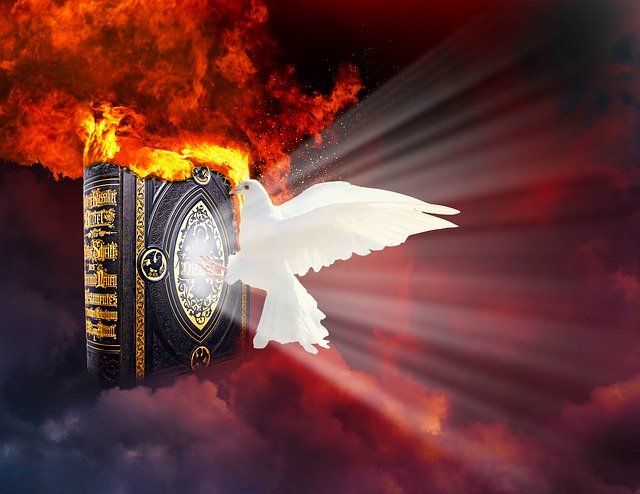 MN asks: "I recently attended a Healing Mass where we were told that 'because of the Holy Spirit,' some of us might fall over while being prayed over, but that there would be a 'catcher' behind us to make sure we didn't get hurt. This did indeed happen. People 'went over' and were gently laid on the floor until they 'woke up.' The priest explained that this does not happen to everyone and if it doesn't happen we are no less filled with the Spirit. Later, I researched the idea of resting in the Spirit on the internet and found differing opinions on this phenomenon. Could you blog about this?"
MN asks: "I recently attended a Healing Mass where we were told that 'because of the Holy Spirit,' some of us might fall over while being prayed over, but that there would be a 'catcher' behind us to make sure we didn't get hurt. This did indeed happen. People 'went over' and were gently laid on the floor until they 'woke up.' The priest explained that this does not happen to everyone and if it doesn't happen we are no less filled with the Spirit. Later, I researched the idea of resting in the Spirit on the internet and found differing opinions on this phenomenon. Could you blog about this?"This is an excellent question!
The phenomenon that MN is describing is referred to in the Charismatic Renewal as "resting in the Spirit" or "slain in the Spirit" and is as controversial as it is common.
When I was a regular part of the Catholic Charismatic Renewal, this occurred at every healing mass I attended and I was one of those people who would "go over" at the drop of a hat.
Some charismatics believe that this "falling over" is a manifestation of the healing work of the Holy Spirit in an individual. Today, the practice is generally associated with Pentecostals and Catholic Charismatics, but it is not a new phenomenon. It was very much present in the 18th century revivals in New England, and appeared in the Great Revival that sprang up in Cane Ridge, Kentucky in 1801. These prayer meetings were known to attract up to 15,000 people who experienced manifestations from resting in the spirit to barking like dogs, shaking, howling, and slipping into catatonic death-like states.
Some believe that physical manifestations such as "resting in the Spirit" are signs that the Church is returning to the apostolic age when the gifts of the Holy Spirit described in 1 Corinthians 12 were common in Christian faith communities. These gifts include speaking in tongues, discernment of spirits, prophecy, healing and the working of miracles - all of which are a regular part of any charismatic gathering.
Being "slain in the Spirit" is not part of this list, although there are some who argue that this phenomenon manifested itself in the Garden of Gethsemane when Jesus said "I am he" and the Roman guards fell to the ground (John 18: 4-6). However, others argue that this Scripture has no bearing on the modern manifestation of being "slain in the Spirit" because the latter typically occurs when a priest or minister lays hands on a person in prayer. They have a point. There is no biblical precedence for people falling down when being prayed over. The closest we have to this would be several occasions in the Old and New Testament where people fell over as a result of being overwhelmed by the presence of God (see 1 Kings 8:10-11, Daniel 8:27, Acts 9:3-4; Acts 26:14, Revelation 1:17).
 The criticism about "resting in the Spirit" that carries the most weight is that of the late Leon-Joseph Cardinal Suenens (1904-1996). Suenens was a champion of the Catholic Charismatic Renewal and the man believed to have been responsible for convincing Pope Paul VI in 1975 to give the Church's approval to the Charismatic Renewal. Cardinal Suenens wrote many books on the subject, one of which was entitled, Resting in the Spirit: A Controversial Phenomenon.
The criticism about "resting in the Spirit" that carries the most weight is that of the late Leon-Joseph Cardinal Suenens (1904-1996). Suenens was a champion of the Catholic Charismatic Renewal and the man believed to have been responsible for convincing Pope Paul VI in 1975 to give the Church's approval to the Charismatic Renewal. Cardinal Suenens wrote many books on the subject, one of which was entitled, Resting in the Spirit: A Controversial Phenomenon.
In this book, the Cardinal examines the phenomenon, then analyzes the historical background and theoretical arguments in defense of its authenticity. He ultimately concludes that "resting in the spirit" is not a manifestation of the power of the Holy Spirit and that "it threatens the authenticity and credibility of the Charismatic Renewal."
Cardinal Suenens agreed with other charismatic leaders that it was more properly referred to as the "falling phenomenon" rather than "resting in the spirit" and said it is "most important" that this phenomenon be excluded from liturgical celebrations and that churches should not invite ministers whose prayer or teaching is associated with it.
If "going over" is not associated with the Holy Spirit, then what causes it? Generally, it is believed to be a psychological response rather than a spiritual one.
Father Richard Bain was one of those priests whose healing Masses featured the phenomenon.
"For several years the phenomenon of falling occurred when I prayed with people for healing," he writes in this pamphlet.
"I thought I had a special gift. There were times when as many as 90 percent of the people that I prayed over fell on the ground. Some people would fall even before I touched them or even before they knew I was there. Some people fell when I simply walked by them, some fell while I was reading the gospel, and some fell when I sprinkled Holy Water on them."
For a long time, he believed these people were falling over due to the action of the Holy Spirit, but then he decided to do some reading up on the matter, which is when he discovered Cardinal Suenens' views. His studies also revealed that David du Plessis, the man who represented the Pentecostal Churches at Vatican II, shared the Cardinal's concern. Du Plessis openly warned Catholics not to make the same mistake as Pentecostals by allowing this "falling phenomenon" into their churches, saying it would bring them nothing but trouble.
Father Bain responded to this information by taking steps to eliminate all the elements that were believed to create a psychological environment for the phenomenon to occur - such as having "catchers" at the ready and not talking about "resting in the spirit" before the healing service began. He conducted packed healing Masses for three nights, with up to 1,200 people receiving blessings, and not a single person fell.
In one Mass where he knew people accustomed to "resting in the Spirit" were present, he announced that there would be "no catchers" so the people would have to protect their own heads if they fell. Guess what happened? Not one person fell.
At first, the number of people attending his Masses dropped, and many people urged him to put "resting in the Spirit" back into the service, but he refused because by that time, he was convinced that it was a deception.
Soon, attendance began to increase until it was larger than before!
"The best result of eliminating the phenomenon, however, was that the Masses became much more prayerful. No longer were people being distracted either by hoping to go over, worrying that they would, or counting which priest was putting more people on the floor."
Fr. Bain, like many others, thinks the "falling phenomenon" can sometimes can be attributed to the action of the Holy Spirit, but believes this to be very rare with the majority of these manifestations being purely psychological in nature.
© All Rights Reserved, Living His Life Abundantly®/Women of Grace® http://www.womenofgrace.com
Send your New Age questions to newage@womenofgrace.com
